Installation steps

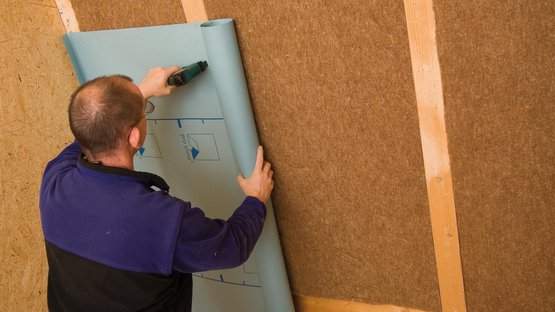
1. Install the membrane
Roll out the membrane and fasten it using staples that are at least 10 mm (⅜”) wide by 8 mm (⁵⁄₁₆”) long at intervals of 10-15 cm (4”-6”) (5-10 cm (2”-4”) for blown-in insulation). Install the membrane leaving an additional 4 cm (1⅝”) overlap at adjacent building structures so that an airtight bond can be applied here subsequently.
1. Install the membrane
Roll out the membrane and fasten it using staples that are at least 10 mm (⅜”) wide by 8 mm (⁵⁄₁₆”) long at intervals of 10-15 cm (4”-6”) (5-10 cm (2”-4”) for blown-in insulation). Install the membrane leaving an additional 4 cm (1⅝”) overlap at adjacent building structures so that an airtight bond can be applied here subsequently.

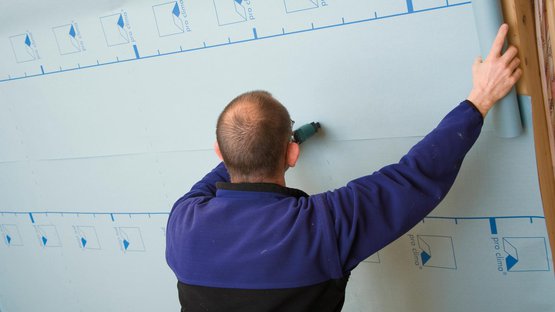
2. Overlap the membranes in the case of horizontal installation
Allow the membranes to overlap by approx. 10 cm (4”) in the case of installation perpendicular to the supporting structure. The marking that is printed onto the membrane will serve as a guide here.
2. Overlap the membranes in the case of horizontal installation
Allow the membranes to overlap by approx. 10 cm (4”) in the case of installation perpendicular to the supporting structure. The marking that is printed onto the membrane will serve as a guide here.

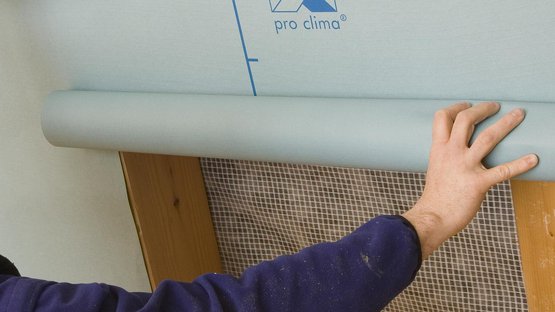
3. Overlap the membranes in the case of vertical installation
Allow for an overlap of at least 1 cm [1/16”] on fixed subsurfaces (e.g. rafters) in the case of installation parallel to the supporting structure.
3. Overlap the membranes in the case of vertical installation
Allow for an overlap of at least 1 cm [1/16”] on fixed subsurfaces (e.g. rafters) in the case of installation parallel to the supporting structure.

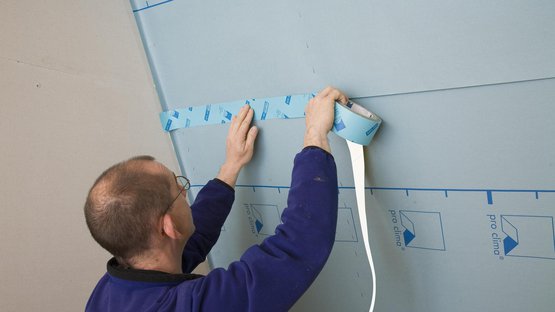
4a. Tape the overlap
Clean the subsurface (dry and free of dust, silicone and grease) and carry out an adhesion test, if necessary. Centre the UNI TAPE system adhesive tape on the overlap and gradually stick it in place, ensuring that there are no folds or tension.
4a. Tape the overlap
Clean the subsurface (dry and free of dust, silicone and grease) and carry out an adhesion test, if necessary. Centre the UNI TAPE system adhesive tape on the overlap and gradually stick it in place, ensuring that there are no folds or tension.

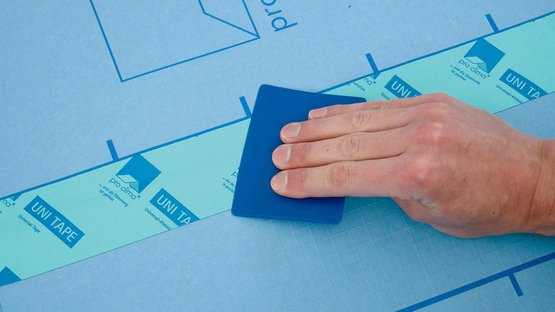
4b. Tape the overlap
Rub firmly using the PRESSFIX application tool to secure the adhesive bond. Ensure that there is sufficient resistance pressure.
4b. Tape the overlap
Rub firmly using the PRESSFIX application tool to secure the adhesive bond. Ensure that there is sufficient resistance pressure.


5. Sealing to smooth, non-mineral subsurfaces ...
... (e.g. knee walls made of wood-based panels) should also be implemented using UNI TAPE system adhesive tape. Centre the tape and gradually stick it in place, ensuring that there are no folds or tension (PRESSFIX).
5. Sealing to smooth, non-mineral subsurfaces ...
... (e.g. knee walls made of wood-based panels) should also be implemented using UNI TAPE system adhesive tape. Centre the tape and gradually stick it in place, ensuring that there are no folds or tension (PRESSFIX).

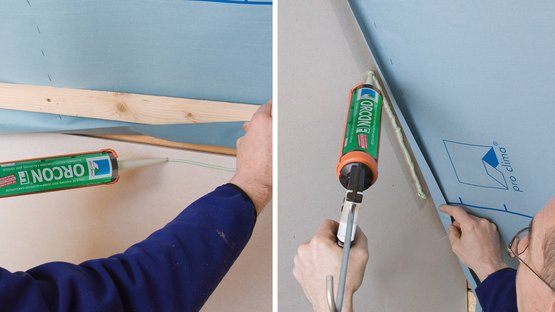
6. Sealing to rough or mineral subsurfaces
Clean the subsurface. Apply a line of ORCON F adhesive sealant of at least d = 5 mm [³⁄₁₆”] , or more in the case of very rough subsurfaces if necessary. Place DB+ onto the adhesive bed, leaving slack to allow for expansion. Do not press the adhesive completely flat.
6. Sealing to rough or mineral subsurfaces
Clean the subsurface. Apply a line of ORCON F adhesive sealant of at least d = 5 mm [³⁄₁₆”] , or more in the case of very rough subsurfaces if necessary. Place DB+ onto the adhesive bed, leaving slack to allow for expansion. Do not press the adhesive completely flat.


7. Sealing to unplastered subsurfaces
Guide the vapour control membrane into position. Leave slack for expansion so as to allow for relative motion between components.
Remove all release films from CONTEGA SOLIDO SL or CONTEGA SOLIDO IQ.
Centre the tape and gradually stick it in place. Rub the tape firmly using the PRESSFIX to secure the adhesive bond.
To achieve airtightness, plaster over the masonry and sealing tape.
7. Sealing to unplastered subsurfaces
Guide the vapour control membrane into position. Leave slack for expansion so as to allow for relative motion between components.
Remove all release films from CONTEGA SOLIDO SL or CONTEGA SOLIDO IQ.
Centre the tape and gradually stick it in place. Rub the tape firmly using the PRESSFIX to secure the adhesive bond.
To achieve airtightness, plaster over the masonry and sealing tape.


8a. Alternative: Sealing to unplastered subsurfaces
Attach the CONTEGA PV plaster-sealing tape to the wall initially at discrete points using ORCON F. The adhesive strip should be facing inwards.
8a. Alternative: Sealing to unplastered subsurfaces
Attach the CONTEGA PV plaster-sealing tape to the wall initially at discrete points using ORCON F. The adhesive strip should be facing inwards.

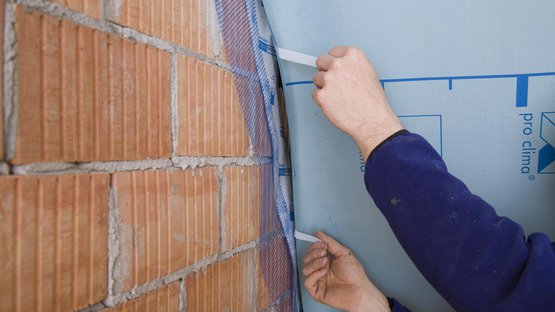
8b. Alternative: Sealing to unplastered subsurfaces
Guide the vapour control membrane into position, remove the release film from CONTEGA PV and stick the vapour control membrane to the tape.
8b. Alternative: Sealing to unplastered subsurfaces
Guide the vapour control membrane into position, remove the release film from CONTEGA PV and stick the vapour control membrane to the tape.

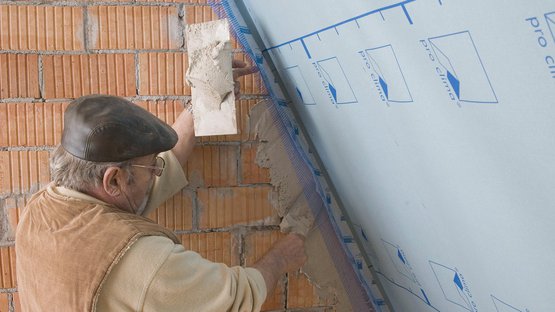
8c. Alternative: Sealing to unplastered subsurfaces
First plaster behind the tape, then apply the tape to the wet plasterwork and plaster over it fully.
8c. Alternative: Sealing to unplastered subsurfaces
First plaster behind the tape, then apply the tape to the wet plasterwork and plaster over it fully.

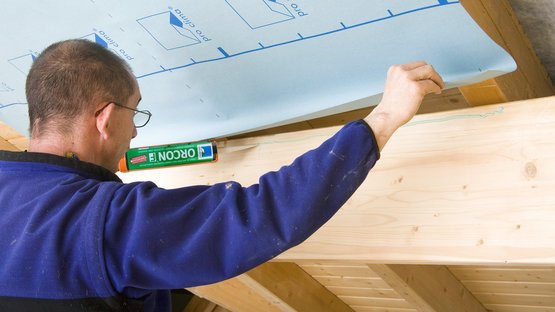
9a. Sealing to roughly sawn timber
Clean the subsurface. Apply a line of ORCON F adhesive sealant of at least d = 5 mm [³⁄₁₆”], or more in the case of very rough subsurfaces if necessary. As an alternative, ORCON MULTIBOND adhesive sealant from a roll can be used.
9a. Sealing to roughly sawn timber
Clean the subsurface. Apply a line of ORCON F adhesive sealant of at least d = 5 mm [³⁄₁₆”], or more in the case of very rough subsurfaces if necessary. As an alternative, ORCON MULTIBOND adhesive sealant from a roll can be used.


9b. Sealing to roughly sawn timber
Place DB+ onto the adhesive bed, leaving slack to allow for expansion. Do not press the adhesive completely flat.
9b. Sealing to roughly sawn timber
Place DB+ onto the adhesive bed, leaving slack to allow for expansion. Do not press the adhesive completely flat.

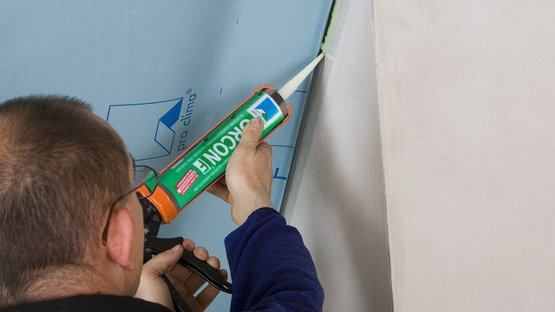
10a. Sealing to plastered chimney (insulated or double-shelled)
Seal DB+ with ORCON F as shown in Figure 6.
10a. Sealing to plastered chimney (insulated or double-shelled)
Seal DB+ with ORCON F as shown in Figure 6.

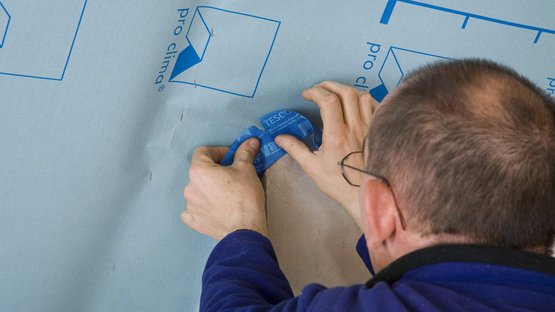
10b. Sealing to plastered chimney (insulated or double-shelled)
Then cut into short pieces of TESCON VANA as far as the centre, create corner shapes and then stick in place.
10b. Sealing to plastered chimney (insulated or double-shelled)
Then cut into short pieces of TESCON VANA as far as the centre, create corner shapes and then stick in place.

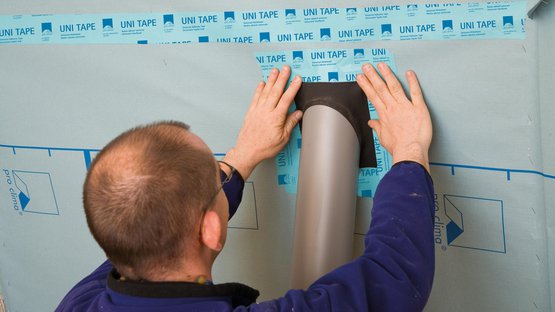
11. Sealing around pipes and cables
Place a KAFLEX or ROFLEX sealing grommet over the cable or pipe and stick it to DB+. The cable grommets are self-adhesive. Tape the pipe grommets to the membrane using TESCON VANA or UNI TAPE.
11. Sealing around pipes and cables
Place a KAFLEX or ROFLEX sealing grommet over the cable or pipe and stick it to DB+. The cable grommets are self-adhesive. Tape the pipe grommets to the membrane using TESCON VANA or UNI TAPE.

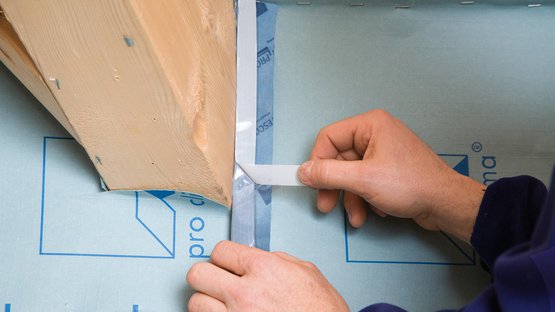
12. Corner sealing
Guide TESCON PROFECT pre-folded corner sealing tape into the corner on the release film and stick the first independent adhesive strip. Then remove the release film and stick the second independent adhesive strip.
12. Corner sealing
Guide TESCON PROFECT pre-folded corner sealing tape into the corner on the release film and stick the first independent adhesive strip. Then remove the release film and stick the second independent adhesive strip.


13. Battens, interior cladding
Install battens (e= max. 65 cm [2’ 2"] ) to bear the weight of the insulation, and install interior cladding to provide protection against UV light and other damage.
13. Battens, interior cladding
Install battens (e= max. 65 cm [2’ 2"] ) to bear the weight of the insulation, and install interior cladding to provide protection against UV light and other damage.

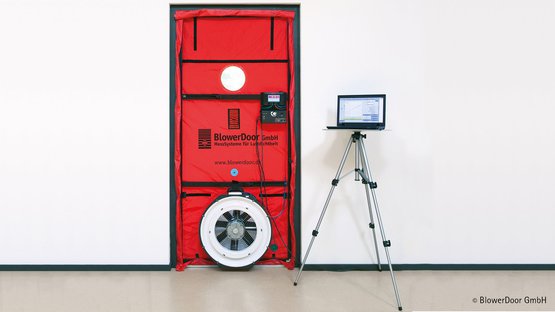
14. Quality assurance
It is recommended that airtightness should be checked using a BlowerDoor test.
14. Quality assurance
It is recommended that airtightness should be checked using a BlowerDoor test.

